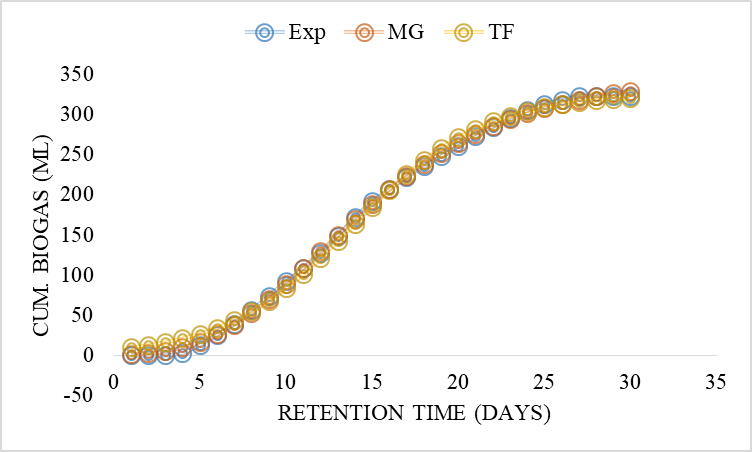Modelling the Effects of Dilute Alkaline Pretreatment of Lignocellulosic Biomass on Biogas Production
Main Article Content
Abstract
This paper simulated an experimental data on biogas production initially aimed to determine the effect of different concentrations of NaOH on the pretreatment of lignocellulosic biomass for possible application in co-digestion with cow dung (CD) and food waste (FW). The data were divided in training and validation subgroups and simulation was run using the nonlinear regression models (modified Gompertz and Transference function models). The modified Gompertz model fitted well with the dataset obtained for 5 and 7% NaOH pretreated with R-squared of 0.999 for both concentrations and RMSE of 0.004 and 0.397 respectively. The Transference function model best fitted the data obtained for 6% NaOH pretreated biomass with an R-squared of 0.997 and RMSE of 0.03. Generally, both models have shown good prediction capacities with the data used in the study. Both experimental data and their simulations have shown that the concentrations of NaOH in solutions used for the pretreatment of biomass have affected the retention time, cumulative gas production, intermediary processes and the methanogenic activities.
Downloads
Article Details

This work is licensed under a Creative Commons Attribution-NonCommercial-NoDerivatives 4.0 International License.
References
Adamu, A. A., & Aluyor, E. O. (2013). Empirical model for predicting rate of biogas production. Global Journal of Engineering Research, 12, 63-68.
Aromolaran, A., & Sartaj, M. (2021). Enhancing biogas production from municipal solid waste through recirculation of blended leachate in simulated bioreactor landfills. Biomass Conversion and Biorefinery, 1-16.
Bala, R., Gupta, G. K., Dasgupta, B. V., & Mondal, M. K. (2019). Pretreatment optimisation and kinetics of batch anaerobic digestion of liquidised OFMSW treated with NaOH: models verification with experimental data. Journal of environmental management, 237, 313-321.
Birta, L. G., & Arbez, G. (2013). Modelling and simulation. London: Springer.
Bissell, C., & Dillon, C. (Eds.). (2012). Ways of thinking, ways of seeing: Mathematical and other Modelling in Engineering and Technology (Vol. 1). Springer Science & Business Media.
Deepanraj, B., Sivasubramanian, V., & Jayaraj, S. (2015). Kinetic study on the effect of temperature on biogas production using a lab scale batch reactor. Ecotoxicology and Environmental Safety, 121, 100-104.
Gibson, A. M., Bratchell, N., & Roberts, T. A. (1987). The effect of sodium chloride and temperature on the rate and extent of growth of Clostridium botulinum type A in pasteurized pork slurry. Journal of Applied Bacteriology, 62(6), 479-490.
Gidado, M., & Clarkson, M. A. (2022). Effect of Dilute Alkaline Pre-treatment of Lignocellulosic Biomass on the Production of Biogas. African Journal of Environmental Sciences and Renewable Energy, 5(1), 38–48. Retrieved from https://publications.afropolitanjournals.com/index.php/ajesre/article/view/182
Jijai, S., & Siripatana, C. (2017). Kinetic model of biogas production from co-digestion of Thai rice noodle wastewater (Khanomjeen) with chicken manure. Energy Procedia, 138, 386-392.
Kafle, G. K., & Chen, L. (2016). Comparison on batch anaerobic digestion of five different livestock manures and prediction of biochemical methane potential (BMP) using different statistical models. Waste management, 48, 492-502.
Kucharska, K., Hołowacz, I., Konopacka-Łyskawa, D., Rybarczyk, P., & Kamiński, M. (2018a). Key issues in modeling and optimization of lignocellulosic biomass fermentative conversion to gaseous biofuels. Renewable energy, 129, 384-408.
Lauwers, J., Appels, L., Thompson, I. P., Degrève, J., Van Impe, J. F., & Dewil, R. (2013). Mathematical modelling of anaerobic digestion of biomass and waste: Power and limitations. Progress in Energy and Combustion Science, 39(4), 383-402.
Lay, J. J., Li, Y. Y., & Noike, T. (1998). Interaction between homoacetogens and methanogens in lake sediments. Journal of fermentation and bioengineering, 86(5), 467-471.
Li, C., Champagne, P., & Anderson, B. C. (2011). Evaluating and modeling biogas production from municipal fat, oil, and grease and synthetic kitchen waste in anaerobic co-digestions. Bioresource technology, 102(20), 9471-9480.
Lübken, M., Gehring, T., & Wichern, M. (2010). Microbiological fermentation of lignocellulosic biomass: current state and prospects of mathematical modeling. Applied microbiology and biotechnology, 85(6), 1643-1652.
Panigrahi, S., Sharma, H. B., & Dubey, B. K. (2020). Anaerobic co-digestion of food waste with pretreated yard waste: a comparative study of methane production, kinetic modeling and energy balance. Journal of Cleaner Production, 243, 118480.
Tsapekos, P., Kougias, P. G., Alvarado-Morales, M., Kovalovszki, A., Corbière, M., & Angelidaki, I. (2018). Energy recovery from wastewater microalgae through anaerobic digestion process: Methane potential, continuous reactor operation and modelling aspects. Biochemical engineering journal, 139, 1-7.
Veluchamy, C., & Kalamdhad, A. S. (2020). Effect of Total Solid Content of Lignocellulose Pulp and Paper Mill Sludge on Methane Production and Modeling. Journal of Environmental Engineering, 146(3), 04019121.
Wainwright, J., & Mulligan, M. (2002). Environmental modeling. Wiley-Blackwell.
Yoruklu, H. C., Ozkaya, B., & Demir, A. (2022). Optimization of liquid fertilizer production from waste seaweed: A design of experiment based statistical approach. Chemosphere, 286, 131885.

